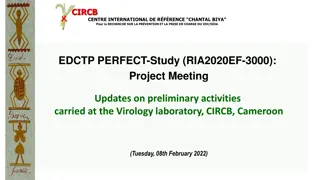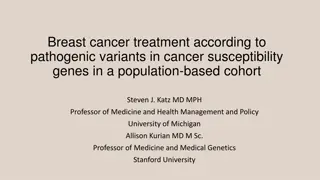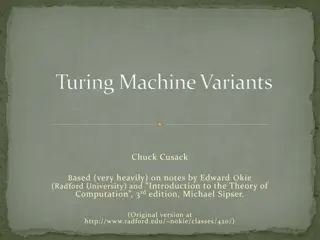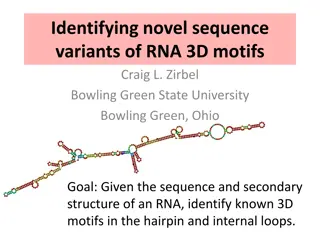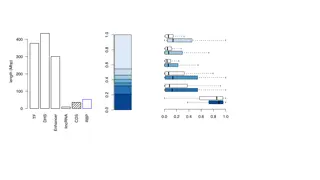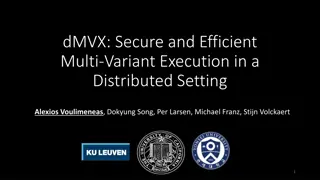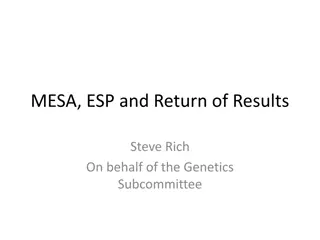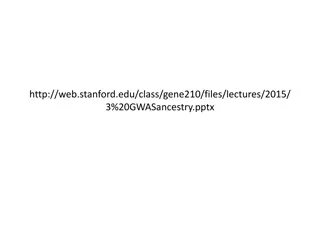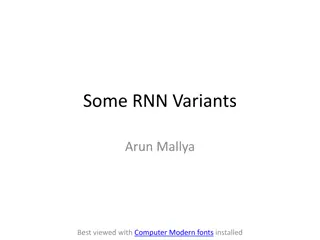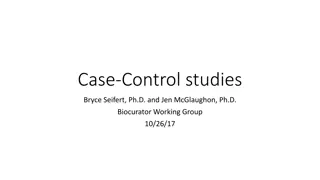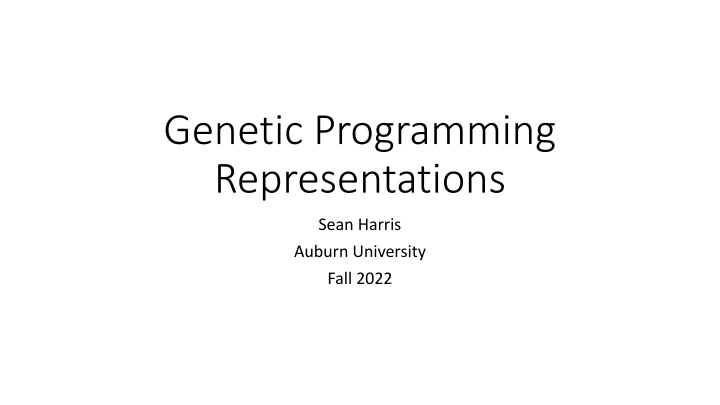
Tree-Based Genetic Programming for Improved Results
"Explore tree-based genetic programming, a popular technique utilizing tree representations for generating solutions. Discover variants, mutations, and recombinations, enhancing interpretability and scalability in genetic programming."
Download Presentation

Please find below an Image/Link to download the presentation.
The content on the website is provided AS IS for your information and personal use only. It may not be sold, licensed, or shared on other websites without obtaining consent from the author. If you encounter any issues during the download, it is possible that the publisher has removed the file from their server.
You are allowed to download the files provided on this website for personal or commercial use, subject to the condition that they are used lawfully. All files are the property of their respective owners.
The content on the website is provided AS IS for your information and personal use only. It may not be sold, licensed, or shared on other websites without obtaining consent from the author.
E N D
Presentation Transcript
Genetic Programming Representations Sean Harris Auburn University Fall 2022
Overview Genetic programming combines primitives (operators and terminals) into a structured genotype There are many different ways to structure the genotype! Five common representations that we ll look at: Tree-based GP Linear GP Cartesian GP Grammatical Evolution Stack-based GP
Tree-Based Genetic Programming Often called Koza-style Most popular form of genetic programming Programs are represented by a tree Inputs to nodes are represented by their children The value of the root node is the program s return value
Tree Representation Often called Koza-style Most popular form of genetic programming Programs represented by a tree Inputs to nodes are represented by their children The value of the root node is the program s return value 7x2+7x-7 - + + * * 6 1 * X X 7 X 7
Tree Mutation Two kinds of mutation are used with trees Subtree mutation re- generates a subtree Point mutation randomizes an operator or terminal Both are often used together 7x2+7x-7 9x2-7 - - + + + + * * 6 1 * * 6 1 * X X 7 * X X * X 7 X 7 2 X
Tree Recombination 7x2+7x-7 6x2+7x-6 Recombination uses subtree crossover Subtree crossover has high locality compared to other operators - - + + + + * * 6 1 * * 6 * x3+3x2 * X X 7 * X X 7 X X * X 7 X 7 + * X 3 X X
Notes About Tree-Based GP Relatively human-interpretable compared to other representations Needs methods like automatically-defined-functions to reuse results The entire tree is used, no introns Only generates one output per tree; if you need more than one: Multiple trees are commonly used together as a single genotype One tree can be run repeatedly, changing or updating the inputs
Variant: Strongly-Typed Genetic Programming A versatile form of tree-based genetic programming Each primitive has data types for inputs and outputs Initialization and variation operators ensure that the input types for parent nodes match the output types of their child nodes For subtree crossover, ensure the parent s subtree has the same output type as the donor s subtree
Linear Genetic Programming Represents programs as lists of instructions analogous to assembly language Executed in order of the list Instructions use registers for inputs and outputs Registers include inputs, outputs, and working registers Often uses a real language 7x2+7x-7 (6) MOV 1 0 0 0 0 0 0 0 0 x x x x x x x x (1) MOV 2 7x2+7x 7x2+7x-7 1 1 1 1 1 1 1 1 6 6 6 7x 7x 1 2 ADD 3 7x2 7x2 7x2 2 2 2 2 2 2 2 2 1 1 1 0 3 MUL 1 3 3 3 3 3 3 3 3 7 7 7 7 7 0 1 MUL 2 1 2 ADD 1 1 3 SUB 1
Linear Mutation Replace a section of the genome with a new, random one The length of the new sequence can differ, allowing the program to change in size Moderately disruptive, as the contents of registers can change 7x2+7x-7 49x2-7 (6) MOV 1 (6) MOV 1 (1) MOV 2 (1) MOV 2 1 2 ADD 3 1 2 ADD 3 0 3 MUL 1 0 3 MUL 1 0 1 MUL 2 1 1 MUL 1 1 2 ADD 1 1 3 SUB 1 1 3 SUB 1
Linear Recombination Recombination uses a crossover operator Must take into account the possible differing lengths Moderately disruptive, as the contents of registers can change 7x2+7x-7 x3+3x2 7 (6) MOV 1 0 MOV 1 (6) MOV 1 (1) MOV 2 0 1 MUL 1 (1) MOV 2 1 2 ADD 3 0 MOV 2 1 2 ADD 3 0 3 MUL 1 (3) MOV 3 (3) MOV 3 0 1 MUL 2 2 3 ADD 2 2 3 ADD 2 1 2 ADD 1 2 1 MUL 1 1 2 ADD 1 1 3 SUB 1 1 3 SUB 1
Notes About Linear Genetic Programming Registers can be reused, allowing for smaller genotypes Performance is highly sensitive to number of registers Too few limits the working space of the program Too many results in an overly large search space Genotypes can contain introns, pieces of genetic material which have no effect on fitness Introns tend to be positive for evolution, as they can store functional but unused segments of programs Programs can have multiple outputs by adding more output registers
Cartesian Genetic Programming Often used in evolving circuits Represents programs as directed acyclic graphs stored in a grid Nodes are arranged into layers, where each layer only accepts inputs from earlier layers Parameter for how far backwards nodes can accept inputs 7x2+7x-7 <I>= x X <1>= 6 <2>= 1 <3>= <I>+<I> 6 1 <4>= <1>+<3> <5>= <1>+<2> <6>= <2>*<I> + * <7>= <5>*<6> <8>= <4>-<4> <9>= <6>+<1> * <10>= <7>*<6> <11>= <7>-<5> <12>= <6>+<9> * - <13>= <7>+<10> <14>= <11>*<7> <15>= <10>+<9> + <O>= <15>
Canonical CGP No recombination Uses a 1+ evolutionary strategy, with as low as 4 Children dominate parents if fitness is not worse Neutral mutations are allowed to accumulate, to allow evolution of introns 15
Cartesian Mutation 7x2+7x-7 7x Randomly mutate a node, changing the operator and input nodes Often changes which nodes are used without modifying the old ones <I>= x <I>= x <1>= 6 <2>= 1 <3>= <I>+<I> <1>= 6 <2>= 1 <3>= <I>+<I> <4>= <1>+<3> <5>= <1>+<2> <6>= <2>*<I> <4>= <1>+<3> <5>= <1>+<2> <6>= <2>*<I> <7>= <5>*<6> <8>= <4>-<4> <9>= <6>+<1> <7>= <5>*<6> <8>= <4>-<4> <9>= <6>+<1> <10>= <7>*<6> <11>= <7>-<5> <12>= <6>+<9> <10>= <7>*<6> <11>= <7>-<5> <12>= <6>+<9> <13>= <7>+<10> <14>= <11>*<7> <15>= <10>+<9> <13>= <7>+<10> <14>= <11>*<7> <15>= <10>+<9> <O>= <15> <O>= <12>
Notes About Cartesian Genetic Programming Cells can be reused, allowing for smaller genotypes Limit on program size which needs to be tuned, but prevents bloat Multiple output cells can be used Very nonstandard EA configuration! Strong results for agent-based AI, comparable to neural network techniques for reinforcement learning Evolving simple programs for playing Atari games, by Wilson et al. (2018)
Variant: Differentiable CGP A form of Cartesian genetic programming which uses differentiable primitives Enables backpropagation and gradient descent to precisely tune constants Primarily made for symbolic regression, but can be applied anywhere where gradients are available Differentiable Genetic Programming, by Izzo et al. (2016)
Grammatical Evolution 2,2,2,1,2,3,2,3,1,1,1,2,7,1,1,2,3,1,1,1,2,7,2,1,1,2,6,1,2,1 Individuals are represented as a list of expansions for a context- free grammar designed for the application Allows for fine-tuning of the search space if characteristics of the desired programs are known Need a method of handling incomplete sequences of expansions ((((x*7)*x)+(x*7))-(6+1)) 7x2+7x-7 1. E -> T 2. E -> NT 1. T -> x 2. T -> # 1. NT -> (E+E) 2. NT -> (E-E) 3. NT -> (E*E) 4. NT -> (E/E) n. # -> n
Grammatical Mutation 2,2,2,1,2,3,2,3,1,1,1,2,7,1,1,2,3,1,1,1,2,7,2,1,1,2,6,1,2,1 Replaces a sequence of expansions with a new sequence, which may vary in length Can have catastrophic effects on the rest of the genotype due to high nonlocality Recombination functions analogously ((((x*7)*x)+(x*7))-(6+1)) 7x2+7x-7 2,2,1,1,1,2,3,2,3,1,1,1,2,7,1,1,2,3,1,1,1,2,7,2,1,1,2,6,1,2,1 (x-3) x-3 1. E -> T 2. E -> NT 1. T -> x 2. T -> # 1. NT -> (E+E) 2. NT -> (E-E) 3. NT -> (E*E) 4. NT -> (E/E) n. # -> n
Notes About Grammatical Evolution Extremely powerful ability to fine-tune the search space, though this can lead to bias Implementation of typed GP is simple Extremely poor locality from genetic operators High non-uniform redundancy, meaning some phenotypes are underrepresented Frequently used for evolution on existing programming languages
Stack-Based Genetic Programming 7x2+7x-7 Individuals are represented as a list of instructions which push and pull values from the stack Program inputs are pushed to the stack and outputs are left on the stack by the end Complexity grows with multiple stacks, or operations that manipulate the stack Same operators as linear GP PUSH x PUSH 7 7x2+7x-7 MUL - PUSH X MUL + + PUSH X PUSH 7 * * 6 1 MUL ADD * X X 7 PUSH 6 PUSH 1 X 7 ADD SUB
Variant: PushGP The dominant form of stack-based genetic programming Implements the Push language, based on the Forth language Individuals represent instructions as a self-modifiable stack A variant, PushPop, makes individuals encode their own variation operators Genetic Programming and Autoconstructive Evolution with the Push Programming Language, by Spector and Robinson (2002) 23
Notes About Stack-Based GP With one stack, programs are very similar to tree-based GP Multiple data types can be represented with a stack for each type Allows for introns if extra data is pushed and never popped Can represent existing stack-based languages Mostly used to study automatic code generation and repair
Case-study: SAT Solver These five GP types were implemented as hyper-heuristics for black-box search algorithms for the 3-SAT problem Hyper-heuristic fitness based on the fitness of the best search algorithm generated at solving the 3-SAT problem The choice of representation strongly affects performance! 2000 Number of Clauses Satisfied 1980 1960 1940 1920 1900 1880 1860 1840 1820 1800
Recommended Reading A Field Guide to Genetic Programming, by Poli, Langdon, and McPhee (2008) A well-regarded free textbook on genetic programming, which covers many of these variants (and others!) Cartesian genetic programming: its status and future, by Julian Miller (2020) A recent and extensive survey paper on Cartesian genetic programming (which isn t covered very well by the Field Guide)



